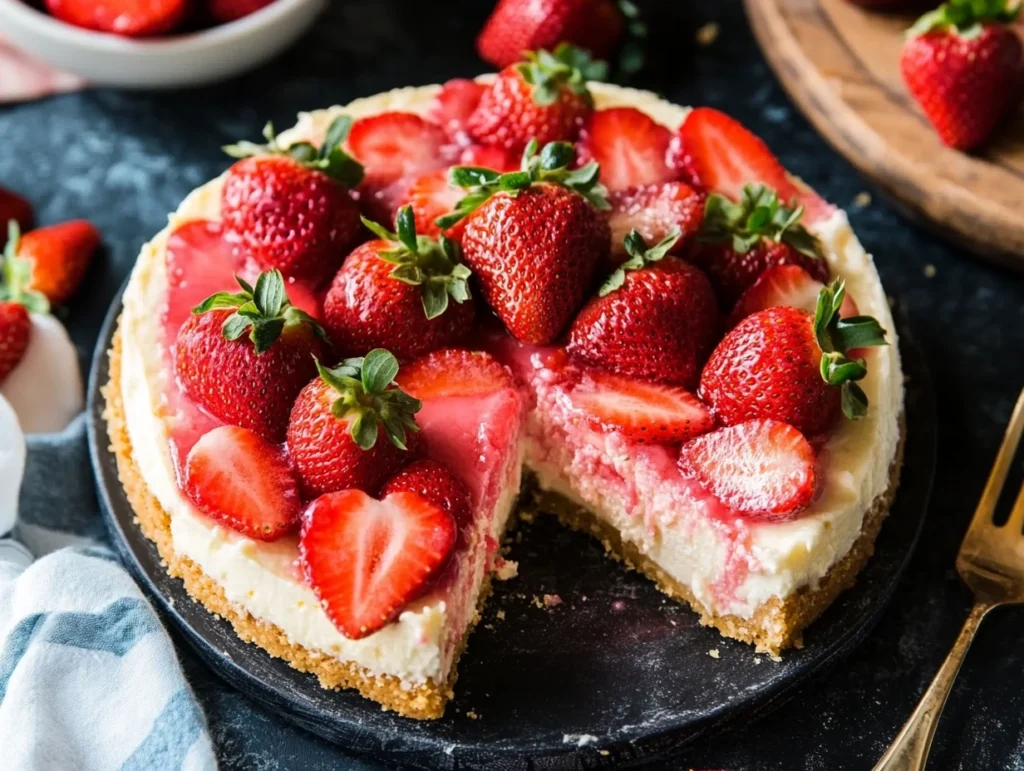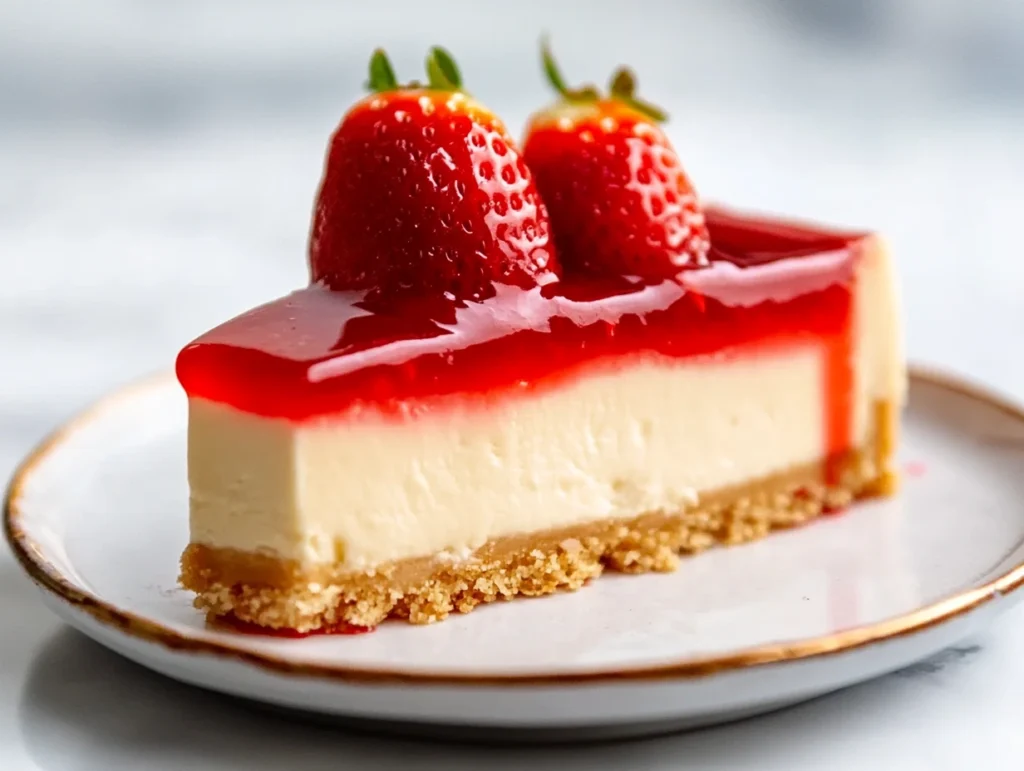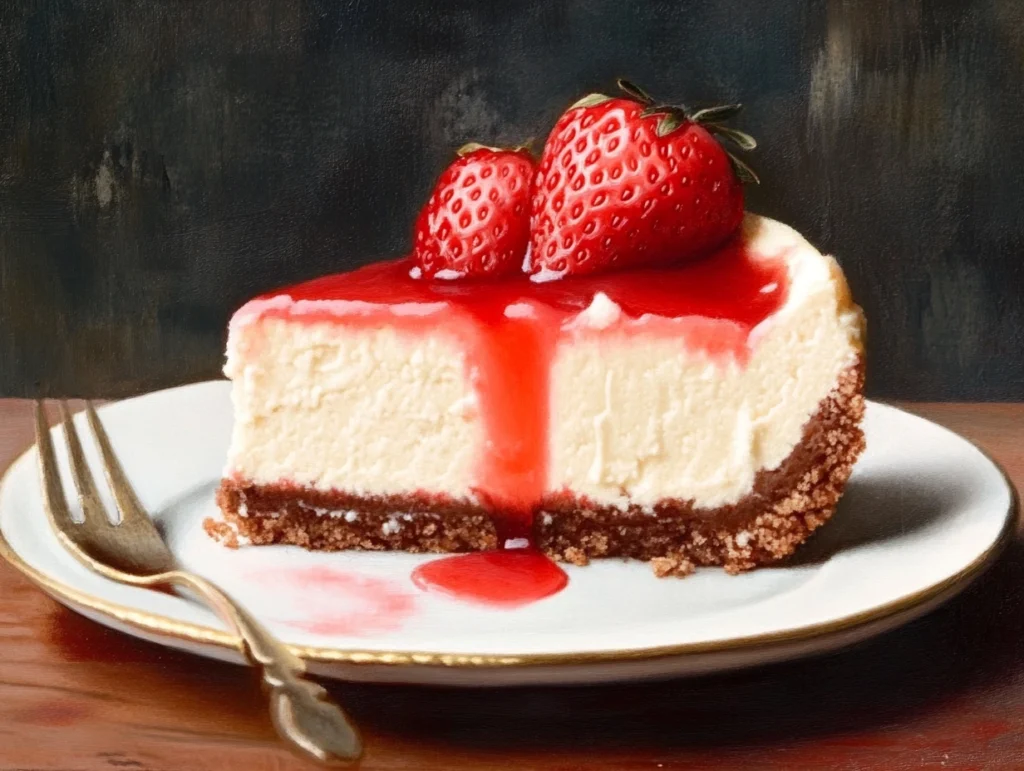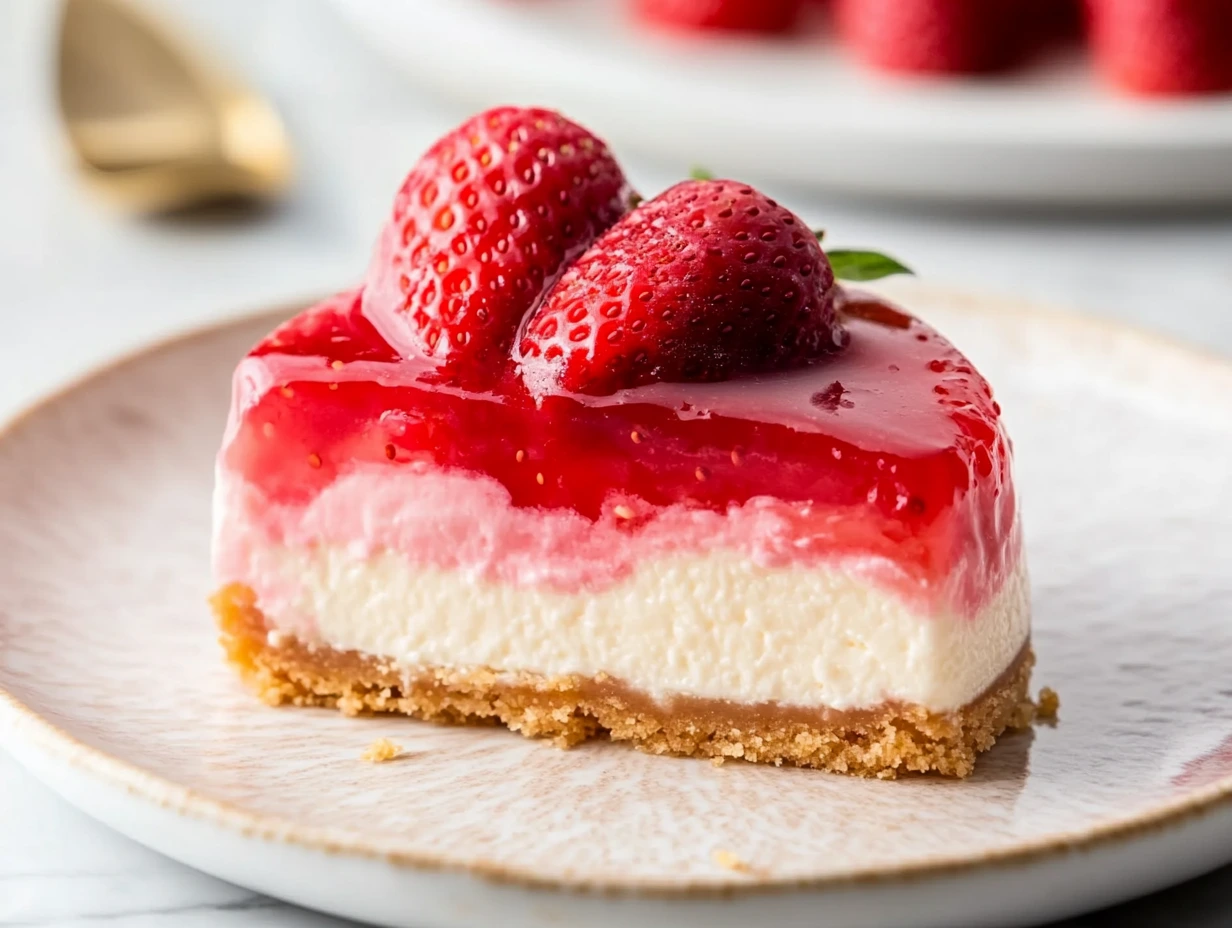Who can resist the allure of a perfectly crafted strawberry cheesecake? With its creamy filling, buttery crust, and sweet-tart strawberry topping, this dessert is a showstopper for any occasion. However, achieving that picture-perfect cheesecake can be tricky, even for seasoned bakers.

1. Understanding Strawberry Cheesecake
Strawberry cheesecake is a harmonious blend of flavors and textures that relies on three key components:
- The Crust: Made with crushed graham crackers, digestive biscuits, or similar cookies mixed with melted butter. It serves as the foundation, adding a crunchy contrast to the creamy filling.
- The Filling: A luscious mixture of cream cheese, sugar, eggs, and often a splash of vanilla or citrus zest. Proper mixing techniques ensure a silky and smooth consistency.
- The Strawberry Topping: The crowning glory of the cheesecake, made with fresh strawberries, a strawberry compote, or a glaze to bring a vibrant, tangy-sweet finish.
2. Essential Tools You Need
Achieving cheesecake perfection starts with having the right tools. Here’s a list of must-haves:
- Springform Pan: Ensures easy removal of your cheesecake without damaging the crust or filling.
- Mixing Bowls: Multiple bowls for combining wet and dry ingredients separately.
- Electric Mixer: A stand or hand mixer is essential for achieving a smooth filling without overmixing.
- Rubber Spatula: For scraping down the sides of the bowl to ensure even mixing.
- Baking Sheet or Roasting Pan: Used to create a water bath (bain-marie) to prevent cracks during baking.
- Cooling Rack: Helps cool the cheesecake evenly before chilling.
- Offset Spatula: Perfect for spreading the topping evenly and giving your cheesecake a professional finish.
3. Choosing the Right Ingredients
The quality of your ingredients is the cornerstone of an exceptional strawberry cheesecake. Each component contributes to the overall taste, texture, and presentation, so it’s essential to choose wisely.
a. The Importance of Fresh Strawberries
Fresh strawberries are the star of your cheesecake topping. Their natural sweetness and vibrant color elevate the dessert, making it not only delicious but visually stunning.
- Flavor: Fresh strawberries provide a bright, tangy-sweet flavor that balances the richness of the cream cheese filling.
- Texture: Ripe strawberries add a pleasing contrast to the creamy filling. Soft, overripe berries can result in a mushy topping, so select firm, ripe strawberries with a deep red hue.
- Versatility: Use fresh strawberries for garnishing, making compote, or creating a luscious glaze.
b. Cream Cheese Quality Matters
Cream cheese is the heart of your cheesecake filling, so its quality can make or break your dessert.
- Full-Fat Cream Cheese: Always use full-fat cream cheese for the creamiest and most indulgent texture. Low-fat options can result in a less rich and watery filling.
- Room Temperature: Allow the cream cheese to come to room temperature before mixing. This prevents lumps and ensures a smooth consistency.
- Trusted Brands: Stick to well-known, high-quality brands for consistent results. Specialty or organic options can also enhance the flavor.
4. Crafting the Perfect Crust
A well-made crust is the foundation of a great strawberry cheesecake. It provides the structure and a delightful crunch that contrasts beautifully with the creamy filling.
a. Ingredients for a Great Crust
The key to a perfect crust lies in selecting the right ingredients and achieving a balance of taste and texture:
- Graham Crackers or Biscuits: Use finely crushed graham crackers or digestive biscuits for a classic base. For variety, consider adding a portion of crushed nuts.
- Butter: Melted unsalted butter binds the crumbs together and adds richness. Adjust the amount to ensure the crust holds its shape without being greasy.
- Sugar: Granulated or brown sugar enhances the flavor and helps the crust caramelize slightly for a firm texture.
b. Preventing a Soggy Base
A soggy crust can ruin an otherwise perfect cheesecake, but you can avoid this with a few simple techniques:
- Pre-bake the Crust: Bake the crust for 8-10 minutes before adding the filling. This step sets the base and prevents it from becoming soggy.
- Use a Barrier: Brush the crust with a thin layer of melted chocolate or egg wash after pre-baking. This creates a protective seal.
- Chill Before Baking: Allow the crust to cool completely or refrigerate it before adding the filling.

5. Mastering the Cheesecake Filling
The filling is the heart of your cheesecake, and achieving a smooth, creamy texture is the ultimate goal.
a. Mixing Techniques for Perfection
Proper mixing is crucial for a flawless filling:
- Room-Temperature Ingredients: Allow cream cheese, eggs, and other ingredients to reach room temperature to ensure smooth blending.
- Avoid Overmixing: Overmixing incorporates too much air, which can cause cracks during baking. Mix just until the ingredients are combined and smooth.
- Scrape the Bowl: Use a rubber spatula to scrape down the sides and bottom of the mixing bowl regularly to prevent lumps.
b. Achieving the Right Sweetness
Balancing sweetness is key to a filling that isn’t overwhelming:
- Start with Less Sugar: Begin with a smaller amount of sugar and adjust to taste. This allows the tanginess of the cream cheese to shine through.
- Complementary Flavors: Add a splash of vanilla extract, lemon zest, or a pinch of salt to enhance the overall flavor profile.
- Taste as You Go: Always taste the filling before baking to ensure it’s perfectly balanced.
6. Baking Tips for the Ideal Texture
Baking your cheesecake to perfection is a fine art that requires attention to detail. Following the right techniques will ensure a creamy, even texture.
a. Why Water Baths Are Essential
A water bath (bain-marie) is a game-changer for cheesecake baking:
- Prevents Cracks: The steam generated in the oven keeps the surface of the cheesecake moist, reducing the risk of cracking.
- Ensures Even Cooking: The water bath surrounds the cheesecake with gentle, even heat, preventing overbaking on the edges while the center sets.
- How to Prepare: Wrap the springform pan in aluminum foil to prevent leaks, place it in a larger pan, and fill the outer pan with hot water until it reaches halfway up the sides of the springform pan.
b. Temperature Control
Maintaining the right oven temperature is critical:
- Preheat Your Oven: Ensure your oven is fully preheated before placing the cheesecake inside.
- Low and Slow: Bake at a low temperature (around 325°F or 160°C) for a longer time to achieve a smooth and creamy texture.
- Avoid Sudden Temperature Changes: Rapid temperature drops can cause cracks. Turn off the oven and leave the cheesecake inside with the door slightly ajar for 30 minutes before removing it to cool further.
7. Cooling and Setting the Cheesecake
Proper cooling and setting are just as important as baking when it comes to achieving the perfect cheesecake.
a. Avoiding Cracks
To keep the surface of your cheesecake smooth and crack-free:
- Cool Gradually: Avoid exposing the cheesecake to sudden changes in temperature. Let it cool in the oven first, then transfer it to a wire rack.
- Run a Knife Along the Edge: Once the cheesecake is out of the oven, run a thin knife around the edges of the pan to release the filling and prevent cracks as it contracts while cooling.
- Be Patient: Allow the cheesecake to cool completely at room temperature before chilling.
b. Refrigeration Best Practices
Chilling the cheesecake is essential for setting the texture and flavors:
- Optimal Chilling Time: Refrigerate the cheesecake for at least 4-6 hours, but overnight is ideal for the best results. This allows the flavors to develop fully and the texture to firm up.
- Cover It Up: Cover the cheesecake with plastic wrap or foil to prevent it from absorbing odors from the fridge.
- Serve Chilled: A properly set cheesecake is firm yet creamy and holds its shape when sliced.

8. Perfecting the Strawberry Topping
The topping is the crowning glory of a strawberry cheesecake, providing flavor, texture, and visual appeal. Master these techniques for a stunning result.
a. Making a Fresh Strawberry Glaze
A fresh strawberry glaze adds a vibrant, glossy finish that enhances the cheesecake’s flavor:
- Ingredients: Combine fresh strawberries, sugar, lemon juice, and cornstarch or gelatin. The cornstarch thickens the glaze, while lemon juice brightens the flavor.
- Preparation: Cook the strawberries with sugar and lemon juice over medium heat until they release their juices. Mix cornstarch with a small amount of water, then stir it into the strawberry mixture. Cook until thickened.
- Strain for Smoothness: If you prefer a smoother glaze, strain the mixture to remove seeds and chunks before cooling.
- Cooling: Allow the glaze to cool to room temperature before spreading it on the cheesecake to prevent melting the filling.
b. Arranging Strawberry Slices Like a Pro
The way you arrange strawberries on top of your cheesecake can turn it into a show-stopping centerpiece:
- Uniform Slices: Slice strawberries evenly to create a neat and consistent look.
- Spiral Pattern: Arrange slices in a circular pattern, starting from the outer edge and working inward to form a beautiful spiral.
- Layering: Layer the strawberries slightly overlapping for a full, luxurious effect.
- Finishing Touch: Brush the arranged strawberries with a thin layer of the prepared glaze to lock in freshness and add shine.
9. Common Mistakes to Avoid
Even the most seasoned bakers can encounter challenges when making cheesecake. Here’s how to sidestep some common pitfalls:
- Overmixing the Batter: Too much air in the batter can cause the cheesecake to rise unevenly and crack. Mix just until combined.
- Skipping the Water Bath: Omitting the water bath can lead to uneven cooking and cracks. Always use one for the best results.
- Opening the Oven Door Frequently: This can cause temperature fluctuations that result in cracks or uneven baking. Resist the urge to peek!
- Rushing the Cooling Process: Moving the cheesecake to the fridge while it’s still warm can cause it to sweat or crack. Let it cool gradually.
- Using Low-Quality Ingredients: Subpar cream cheese or flavorless strawberries will compromise the cheesecake’s taste. Always use fresh, high-quality ingredients.
10. FAQs About Strawberry Cheesecake
Strawberry cheesecake can spark curiosity and questions, especially for those new to baking. Here are answers to some of the most frequently asked questions:
Q: Is cheesecake better baked or unbaked?
- Baked Cheesecake: Known for its dense, creamy texture, baked cheesecake is the traditional choice. It requires careful baking and cooling but delivers a rich and indulgent result.
- Unbaked Cheesecake: This no-bake version is lighter and softer, relying on gelatin or refrigeration to set. It’s quicker and great for those seeking a fuss-free dessert.
- Which is better? It depends on personal preference—baked cheesecake offers a classic, robust flavor, while unbaked cheesecake is simpler and perfect for warm weather.
Q: What are the three types of cheesecake?
- New York Style Cheesecake: Dense, creamy, and rich, often flavored with vanilla and made with heavy cream or sour cream.
- Classic Cheesecake: A lighter and less dense version with a more delicate texture. Often paired with fruit toppings like strawberries.
- No-Bake Cheesecake: Made without baking, it’s set in the fridge using gelatin, whipped cream, or similar stabilizers.
Q: What is the difference between New York style cheesecake and regular cheesecake?
- New York Style Cheesecake: Known for its ultra-dense and creamy texture, thanks to heavy cream or sour cream, it uses more cream cheese than regular cheesecake and is typically baked at a higher temperature.
- Regular Cheesecake: Lighter, less dense, and often slightly sweeter, with a less intense cream cheese flavor. Regular cheesecake recipes may vary widely and can include a range of fillings or toppings.
Q: Which cheese is better for cheesecake?
- Cream Cheese: The most common and widely preferred option, offering a creamy and tangy base for both baked and no-bake cheesecakes.
- Mascarpone Cheese: Adds a milder, slightly sweeter flavor and a smoother texture, often used in Italian-style cheesecakes.
- Ricotta Cheese: Creates a lighter, grainier texture and is commonly used in Italian cheesecakes.
- Cottage Cheese: Occasionally used in low-fat or rustic recipes but lacks the smoothness of cream cheese.
To complement your understanding of creating a strawberry cheesecake, explore other fruit-inspired desserts such as the zesty delights of lemon cupcakes. Additionally, if you’re interested in alternative base options, consider trying a cookie crust like in the banana bread cookies recipe, which offers a unique twist to traditional crusts.
For those keen on experimenting with variations of sweet toppings, check out the rich banana cream cake or the layered indulgence of a banana split cake, which might inspire creative spins for your cheesecake garnishes.
11. Conclusion
Creating the perfect strawberry cheesecake is both an art and a science. By understanding the key components, selecting high-quality ingredients, and mastering the techniques for baking, cooling, and decorating, you can achieve a dessert that’s as delicious as it is visually stunning.
Whether you’re preparing it for a special occasion or simply to satisfy a craving, each step plays a vital role in delivering a creamy, flavorful, and beautifully topped cheesecake. With the tips and insights shared in this guide, you’re well-equipped to impress family, friends, and yourself with a flawless strawberry cheesecake.

